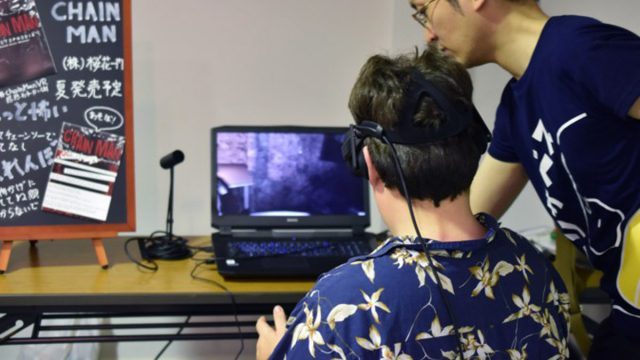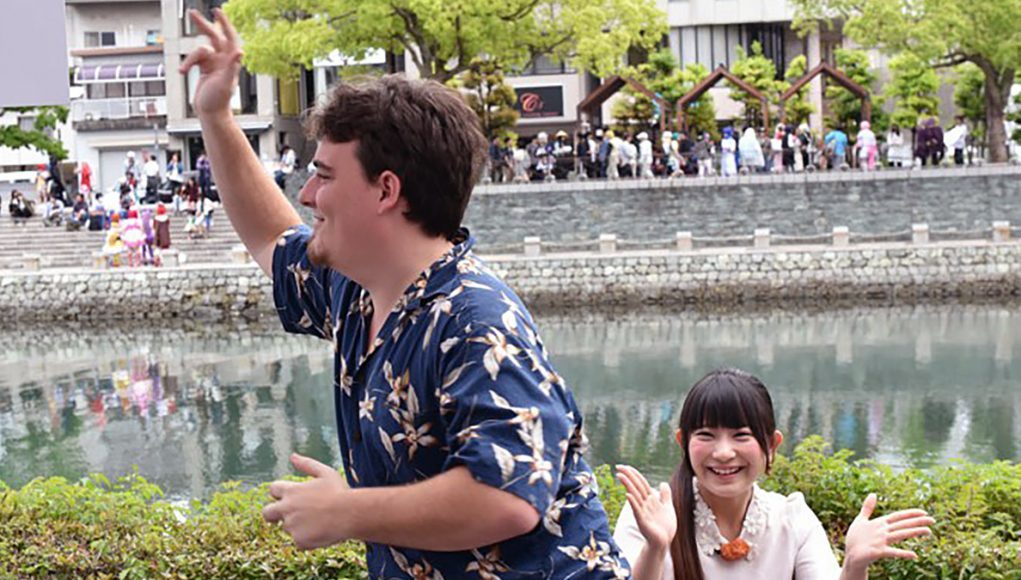The Japanese VR Ecosystem
MoguraVR:
You tested several Japanese VR products at Machi Asobi. Two years ago at Unite 2015 you also experienced Japanese VR content, but what do you think about today’s state of Japan’s VR content?
Palmer Luckey:
What I am feeling has not changed from two or three years ago. I think Japanese VR content is high quality. Especially the Japanese VR indie developer community is making high quality VR content. There are a lot of people in America and Europe owning VR headsets, but the number of actual developers in relation is extremely low. I think there are a lot of VR content developers in Japan. In Japan almost every (PC) VR headset owner is a developer, or has a very high chance of becoming one.
MoguraVR:
About the high quality, what exactly do you think is the strong point of Japanese VR Content?
Palmer Luckey:
I haven’t seen everything, so this is going to be just my impression of what I was able experience. In Japan many developers are placing the focus on the characters. They are paying a lot of attention towards character animation, expressions, voices and about the general mood. I think this is what sets Japanese VR content apart. In the West the development is more focused around the quality of the graphics and of the effects. There is not much consideration being given to the characters, and the animations and voice acting often are low quality.
I think Japanese developers have high expectations of new devices. I think the Japanese are going to be the first to try new devices like smelling devices or haptic feedback devices and devices like the HoloLens. The Japanese market might even try devices unfit for the general consumer market. In the early Rift DK1 days there was a controller called the Razer Hydra, it allowed for hand tracking in VR. Most content that used the Razer Hydra was made in Japan. There was a device called the Noviet Falcon for which all content was created by Japanese developers. No one in the West used it, but in Japan lots of content was made for it.
MoguraVR:
There are people saying Japan is lagging behind Western VR content in terms of getting into stores, what do you think about this?
Palmer Luckey:
Commercial VR content production right now is in a very difficult phase. One cannot say for certain that a dev team that currently has success working in VR will have long time sustainable success. For example, Survios, the studio that created Raw Data, seems to be doing fine. They have announced to have made [more than $1 million USD in a month] of game sales and have simultaneously received a investment of over [$50 million USD]. Looking at it narrowly you could say they are successful. If you take a look at the bigger picture they still need investors to make good content. So it could be said that they are not yet successful on the balance sheet.
I previously said Japan’s indie devs are strong. On the other hand, the number of Japanese studios distributing commercial VR content is very small. There are some Japanese companies that entered the VR market early such as Sony, Colopl, Capcom, and Bandai Namco. I really appreciate Capcom’s Resident Evil 7. In contrast to that there are overwhelmingly many companies making commercial VR games in the West.

MoguraVR:
In Japan there also are many developers that want to found a startup to develop commercial indie VR games, what can they do to succeed?
Palmer Luckey:
I wish I could give a perfect answer to this question, but it is difficult. One problem is that Japanese content is mostly only attractive to Japanese consumers and not Western consumers. If you make content aimed at a Japanese audience the people in the West who make up the biggest part of the VR consumers may not purchase it.
But there still are four pieces of advice I can give. The first one is ‘Think realistically when developing.’ Don’t expect to sell hundreds of millions of units, the VR market is still very young. You have to realistically think about how much money you will make.
My second piece of advice is ‘Find a Partner that does not have the goal of making money.’ A good example of this is many companies trying to use VR as a way to promote this movies, animations… they have a big marketing budget and they do not expect to make money directly via that budget. Working with such companies is a great way to fund your title. As an example think about developers receiving money from Red Bull to display the Red Bull logo in their game.
My third piece of advice is ‘Think carefully about where to distribute your content.’ Delivering the content on PSVR and on the Oculus Platform is not a low threshold. Even Steam might be difficult with Japanese only content. I do not think Steam as a platform is bad, just as a business they are making decisions that don’t seem to care about that market. Creating a new platform for Japanese VR content could be a solution. I don’t have the answer, the platform problem is a difficult one.
My fourth piece of advice is ‘Keep in mind the future of VR is going to be mobile.’ By mobile VR I do not mean Gear VR or smartphone-based VR. I am talking about a headset with a integrated CPU and GPU. No matter how popular PSVR or PC based VR will get I don’t think they will be able to reach a market of hundreds of millions of users. When creating content one should try to make it able to run on a CPU & GPU of mobile hardware. Ultimately this will be the best way to reach a wide audience and to making sales. This is especially true in Japan where PC gaming is not as popular as in the West. Targeting only PC gamers in Japan means you will have only a very small market.
VR’s Mobile Future
MoguraVR:
Do you think integrated VR headsets will become mainstream?
Palmer Luckey:
I think future headsets will be integrated. It will take some time but I think in ten to twenty years 90% of VR users will use integrated headsets. Integrated VR headsets will be much better than those using smartphones like the Gear VR. The performance will not be as good as PC VR but it will have satisfactory performance. In ten years from now mobile VR headsets will be better than current PC VR headsets. They will offer a perfect experience just like current PC VR headsets.
If you are looking to start a business in VR from now on, you should take a good look at the future of mobile VR headsets.
MoguraVR:
Oculus had developed an integrated VR headset prototype called ‘Santa Cruz’. When do you think that technology will see its success?
Palmer Luckey:
I think so. We can now make hardware that is even better than Santa Cruz. I previously said it would take ten to twenty years, but I believe that integrated VR headsets will become the mainstream of the VR market in the next few years.
– – — – –
More From ‘Palmer’s Post-Oculus Interview’ Series:
- Part 2: Virtual Relationships, Sleeping Under a Bridge, & His Next Project
- Part 3: Neural Links, Recorded Memories, and Revolutionizing VR, Again
This article comes from MoguraVR, the exclusive Japan regional partner of Road to VR.







